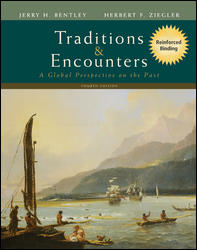Traditions and Encounters, 4th Edition (Bentley)Chapter 20:
WESTERN EUROPE DURING THE HIGH MIDDLE AGESOverviewEuropeans, during the High Middle Ages, built a vibrant and prosperous society. Rising from the foundations laid during the Early Middle Ages—lord-retainer relationships, agricultural innovation, and the Roman Catholic Church—Europe emerged from its long period of relative political instability and economic and intellectual stagnation. The hallmarks of high medieval European culture included: - The consolidation and expansion of regional states. These powerful states sometimes were organized by local rulers and based on lord-retainer relationships, as in France. Other times they were direct conquests, as with the Norman invasion of England. At other times, they were supported or encouraged by the Roman church, like the Holy Roman Empire.
- Economic revitalization. With renewed agricultural surplus, the population expanded and Europe began to reurbanize. Cities grew, and with them grew business, industry, trade, and educational institutions. Long-distance trade networks reappeared, especially in the Mediterranean and Baltic and North Sea regions.
- Continued presence of the Roman Catholic Christianity in virtually all aspects of high medieval life. Through both traditional church institutions and the mass appeal of popular religious practices, the church prospered during this period. The Roman church's influence was felt in education, philosophy, literature, conquest, and travel.
In the High Middle Ages Europe began to interact with increasing regularity with the other regions of the eastern hemisphere. Its days of relative isolation were over.  | 
















